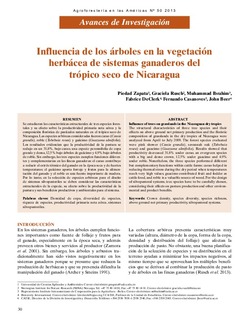Influencia de los árboles en la vegetación herbácea de sistemas ganaderos del trópico seco de Nicaragua
Zapata, Piedad; Rusch, Graciela; Ibrahim, Muhammad; DeClerk, Fabrice; Casanoves, Fernando; Beer, John
Journal article, Peer reviewed
Published version

View/
Date
2013Metadata
Show full item recordCollections
- Publikasjoner fra CRIStin - NINA [2364]
- Scientific publications [1392]
Original version
Agroforestería en las Américas. 2013, 50 30-36.Abstract
Se estudiaron las características estructurales de tres especies forestales y su efecto sobre la productividad primaria neta aérea y la composición florística de pastizales naturales en el trópico seco de Nicaragua. Las especies arbóreas consideradas fueron carao (Cassia grandis), roble (Tabebuia rosea) y guácimo (Guazuma ulmifolia). Los resultados evidencian que la productividad de la pastura se redujo en un 31,8%, bajo carao, una especie perennifolia de copa grande y densa, 12,5% bajo árboles de guácimo y 4,9% bajo árboles de roble. Sin embargo, las tres especies cumplen funciones diferentes y complementarias en las fincas ganaderas: el carao contribuye a reducir el estrés térmico del ganado en la época seca y de fuertes temperaturas; el guácimo aporta forraje y frutos para la alimentación del ganado y el roble es una fuente importante de madera. Por lo tanto, en la selección de especies arbóreas para el diseño de sistemas silvopastoriles se deben considerar las características estructurales de la especie, su efecto sobre la productividad de la pastura y sus beneficios productivos y ambientales para el sistema. Palabras claves: Densidad de copa, diversidad de especies, riqueza de especies, productividad primaria neta aérea, sistemas silvopastoriles. Abstract Influence of trees on grasslands in the Nicaraguan dry tropics The structural characteristics of three tree species and their effects on above ground net primary production and the floristic composition of grasslands in the dry tropics of Nicaragua were analyzed from April to July 2009. The forest species evaluated were pink shower (Cassia grandis), savannah oak (Tabebuia rosea) and guacimo (Guazuma ulmifolia). Results showed that productivity decreased 31.8% under carao, an evergreen species with a big and dense crown, 12.5% under guacimo and 4.9% under roble. Nonetheless, the three species performed different but complementary functions within cattle farms: carao helped in reducing thermal stress during the dry period when temperatures reach very high values, guacimo contributed fruit and fodder as cattle food, and roble is a valuable source of wood. For the design of silvopastoral systems, tree species have to be carefully chosen, considering their effects on pasture production and other environmental and product benefits. Crown density, species diversity, species richness, above ground net primary productivity, silvopastoral systems.